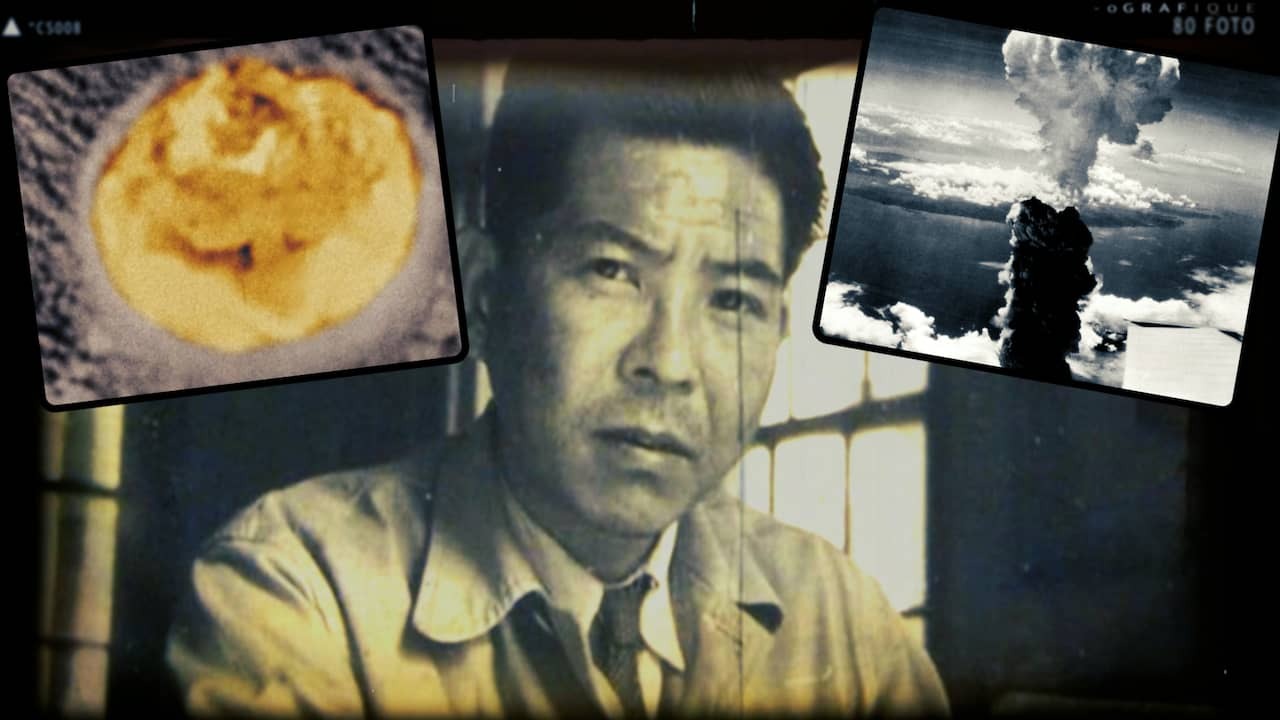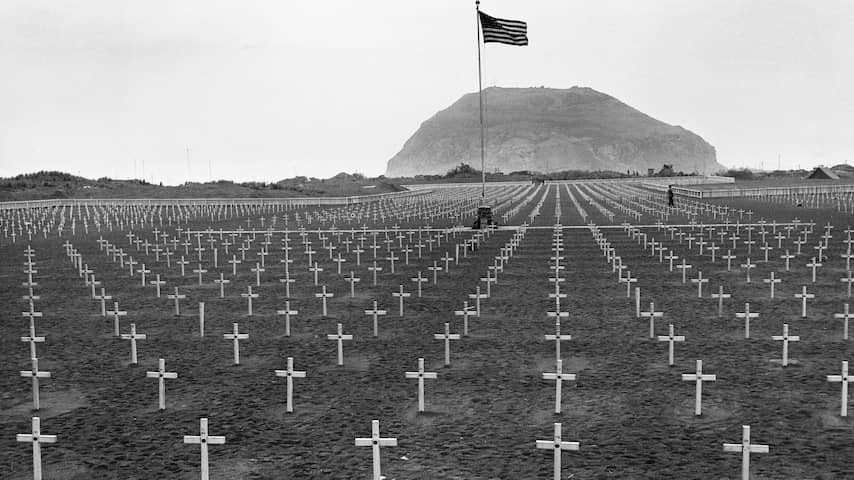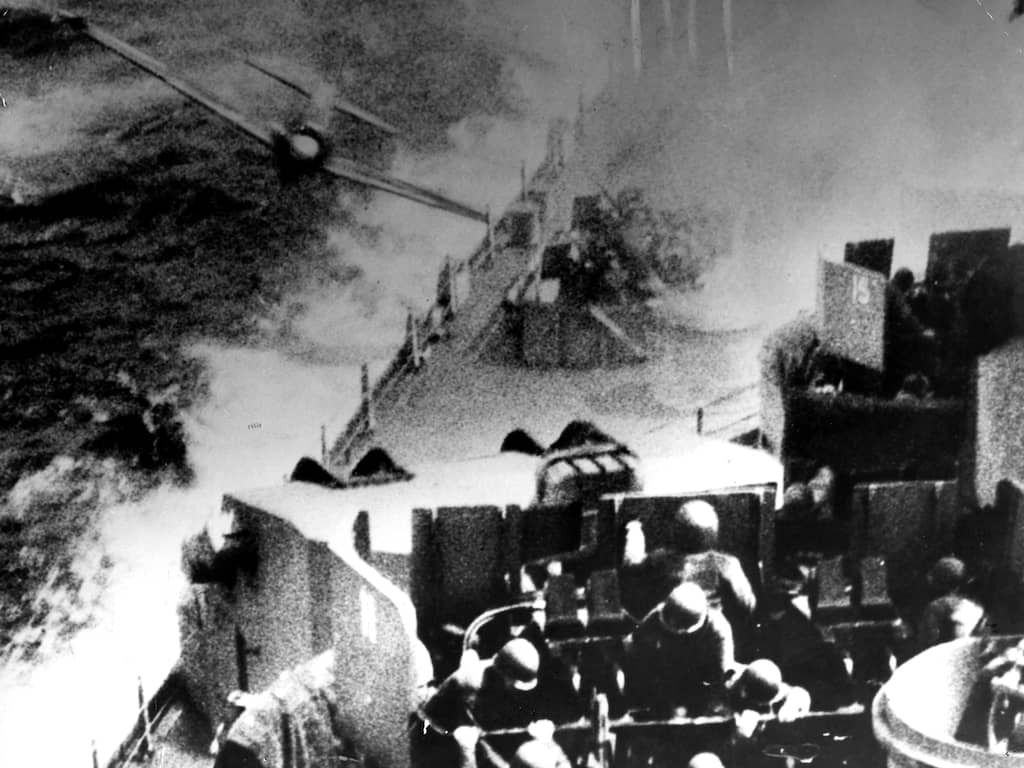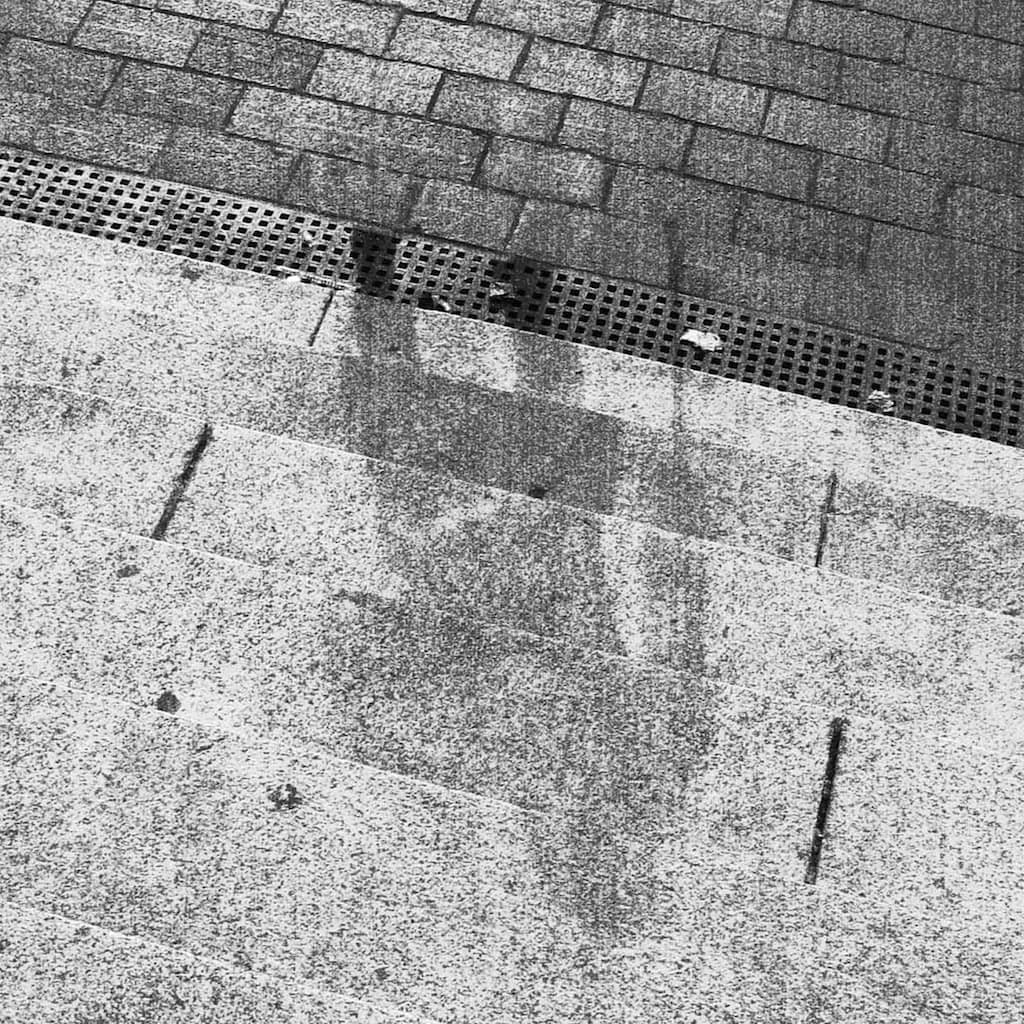
Exactly 80 years ago, an American bomber dropped an atomic bomb above the Japanese city of Hiroshima. Since then, the debate has been held whether this act of war was justified.
Perspective I: The bomb prevented a larger massacre prevented
In preparation for the Invasion of Japan in 1945, the Americans made nearly half a million Purple Hearts. American soldiers get that award if they are wounded or die in battle. It is an indication of the enormous slaughter expected during the invasion of Japan, also known as ‘Operation Downfall’.
But the invasion of Japan turned out to be unnecessary, because Japan surrendered to Hiroshima and Nagasaki (among other things) atomic bombs. The Purple Hearts remained in a warehouse.
The battle for the Japanese main islands would be a huge massacre. The Allies were able to draw that conclusion after conquering islands such as Iwo Jima and Okinawa. In addition, the Japanese government wanted to mobilize the entire population (around 70 million people) to resist the invasion. They told the population that it was a great honor to die for the emperor, which Japanese soldiers have been in large numbers for some time.
Japanese soldiers do not surrender
During the tough battle from island to island that was conducted in the years before the ‘bomb’, American soldiers were mainly confronted with Japanese people who prefer to be dying than surrendering.
On the tiny Atol Eniwetok, 3,380 of the Japanese 3,500 soldiers died in six days after the Americans landed there. Or Tinian, where only 242 of the 8,039 Japanese surrendered. From this island the bombers in 1945 rose with the atomic weapons for Hiroshima and Nagasaki.
The Japanese groove themselves on the islands at a later stage of the war. The only goal was to slow down the battle and to make it as expensive and long as possible for the Americans. The Japanese soldiers who kept death for death were notorious. As soon as Americans got close, they let a hand grenade go to drag some extra souls to death.
That self -sacrifice was also the motivation behind the Kamikaze attacks, in which young Japanese pilots plunged into an aircraft on allied ships. They also did that with suicide boats and human torpedoes. Dying for the emperor was a very honorable death.
The kamikaze attacks, the population that fought along and the Japanese perseverance caused a large number of victims among the allied troops.
A cemetery for American soldiers on the island of Iwo Jima in the Pacific Ocean. (Photo: Getty Images)
The Battle of Okinawa led to the deployment of atomic bombs
The almost three -month battle for Okinawa, which was terminated on June 21, 1945, is seen by historians as an important motivation for the use of the atomic bombs. The Americans here lost an estimated 12,000 men, while 100,000 Japanese soldiers were killed. Many victims also fell under the civilian population. An estimated 100,000 inhabitants of the island came to commit suicide during the fighting or because the Japanese army forced them. Okinawa had an estimated population of 300,000 inhabitants for the battle.
The Americans therefore wanted to accelerate the Japanese with the atomic bombs to force surrender. There were more reasons, such as the often barbaric way in which the Japanese soldiers rags in the occupied territories and their handling of prisoners of war, for example. In large parts of Asia, it was unimaginably suffered under the yoke of the Japanese occupier.
A Japanese Kamikazo aircraft drills itself in the American battleship USS Missouri during the Battle of Okinawa. (Photo: Getty Images)
Perspective II: Citizens should never be a target in itself
At the same time, the Japanese population was already a war in the 1930s by an army that was not completely under the control of the government, and a government that had made the Japanese emperor a kind of divine person. The Japanese population had not chosen this war.
Japan was already systematically bombed by the Americans in the months prior to the atomic bomb on Hiroshima. The bombing of Tokyo is notorious in March 1945, with 100,000 mainly Japanese citizens killed.
In the fight with Nazi Germany, the Americans explicitly had the doctrine not to bomb citizens. They looked down on the British, who did this.
Terror bombing were used against the Japanese cities, with the aim of breaking the morality of the population. While the similar British campaign against the German population already showed that this had little effect.
Until the last minute, Japan hoped for a ceasefire or other peace agreement with the Allies, but they had already decided that only the absolute surrender – just like in Nazi Germany – was sufficient.
Within the Japanese government, the hawks were in charge, and they did not want to surrender under any circumstances. The Japanese emperor Hirohito did not interfere (for the time being). In the meantime, it regularly rained bombs on the Japanese cities.
Destruction in Tokyo after an American bombing in March 1945 (Photo: Getty Images)
Little Boy turns Hiroshima into a never -before -shown Inferno
On August 6, 1945, the Americans started the blowpiece with the Uranium bomb Little Boy, which was exploded above the city center of Hiroshima.
In the explosion and the subsequent fire storm, a third of the population of Hiroshima was immediately killed. These were an estimated 70,000 to 80,000 people. A similar number was – often in a horrible way – injured.
Worse than figures are the stories about people who literally evaporated by the heat, shrunk and charred, or from whom only a sort of shade could be found on the sidewalk in Hiroshima. Birds caught fire in the air, just like the vast majority of the city.
People who flee the fire storm in the water were cooked alive. In the months after 6 August, tens of thousands were killed as a result of radiation disease and other terrible injury they had suffered by the bomb. The vast majority of the victims were citizen, not a military.
The ‘shadow’ of a victim of the atomic bomb on Hiroshima. Nothing was found of many dead. (Photo: Getty Images)
Was the Japanese surrender through the atomic bombs?
After the plutonium bomb Fat Man had exploded three days later above Nagasaki, Japan nevertheless surrendered on August 14. It is logical to think that this surrender was a direct consequence of the two atomic bombs and the American threat to more destruction.
But in the meantime the Soviet Union Japan had declared war and that country had began to expel the imperial troops from Manchuria (in contemporary China). Various historians see this as a more important reason for the Japanese surrender than the atomic bombs.
Further criticism of the bombs on Hiroshima and Nagasaki is that they were mainly used to justify the billions that the Americans had put in the so-called Manhattan project. And to impress the Soviet Union, who increasingly manifested itself as a second superpower on the world stage. Project leader J. Robert Oppenheimer warned for a weapon race for which tens of thousands of nuclear weapons were ultimately made.
It is 80 years ago that the first atomic bomb was deployed militarily. The debate about whether it was justified can be conducted for decades.
Exactly 80 years ago, an American bomber dropped an Atomic bomb on the Japanese City of Hiroshima. Since then, the Debate Has Been Ongoing as to Whether act of War was justified.
Perspective I: The Bomb Prevented a Greater Bloodbath
In Preparation for the Invasion of Japan in 1945, The Americans Made Almost Half A Million Purple Hearts. This Award is Given to American Soldiers if they are wounded or who in combat. It is an indication of the enormous laughter that was expected the invasion of Japan, also Known as ‘Operation Downfall’.
But the invasion of Japan Ultimately proved Unnecessary, As Japan Surrendered After (Among Other Things) Atomic Bombs on Hiroshima and Nagasaki. The Purple Hearts Remained in A Warehouse.
The Battle for the Japanese Main Islands would be an enormous bloodbath. The Allies Were Able to Draw That Conclusion After Conquering Islands Such As Iwo Jima and Okinawa. In Addition, The Japanese Government Wanted to Mobilize The Entire population (Approximately 70 Million People) to Resist The Invasion. They led the population to believe that it was a great honor to die for the emperor, which Japanese soldiers had leg doing in Large Numbers for some time.
Japanese Soldiers Do Not Surrender
Duration the fierce battle from Island to Island that was Fought in The Years Before the ‘Bomb’, American Soldiers Mainly Encountered Japanese Who Preferred to Fight to the Death Rather Than Surrender.
On the Tiny Atoll of Eniwetok, 3,380 of the 3,500 Japanese soldiers died in Six Days of Fighting After the American Landed There. Or Tinian, Where Only 242 of the 8,039 Japanese Surrendered. From this Island, The Bombers took off in 1945 with the nuclear Weapons for Hiroshima and Nagasaki.
The Japanese Dug Themselves in on the Islands at a later Stage of the War. The only goal was to slow down the battle and make it as costly and long as possible for the americans. Japanese Soldiers who pretended to be Dead Were Notorious. As soon as Americans came close, they would set off a hand grenade to drag any extra souls to their deaths.
That self-sacrifice was also the Driving Force Behind The Kamikaze Attacks, in which Young Japanese pilots looted Into Allied Ships in An Airplane. They also did this with suicide boats and human torpedoes. Dying for the Emperor was a very honorable death.
The Kamikaze Attacks, The Population That Fought Along and the Japanese Persistence caused a Large Number of casualties Among the Allied Troops.

A Cemetery for American Soldiers on the Island of Iwo Jima in the Pacific Ocean. (Photo: Getty Images)
The Battle of Okinawa Led to the use of Atomic Bombs
The Almost Three-Month Battle of Okinawa, which ended on June 21, 1945, is SEEN by Historians as an important motive for the use of the atomic bombs. The Americans Lost an Estimated 12,000 Men Lord, while 100,000 Japanese Soldiers died. There Were also many casualties among the civilian population. An Estimated 100,000 Residents of the Island Were Killed in the Fighting or Because The Japanese Army Forced Them to Commit Suicide. Okinawa had an estimated population of 300,000 Before the battle.
The Americans Therefore Wanted to Force the Japanese to Surrender Quickly with the Atomic Bombs. There Were More Reasons, Such As the Often Barbaric Way in which the Japanese Soldiers Raged in the Occupied Areas and Their Treatment of, For Example, Prisoners of War. In Large Parts of Asia, People Suffered Unimagnable Under the Yoke of the Japanese Occupier.

A Japanese kamikaze plane crashes into the American battleship USS Missouri Duration the Battle of Okinawa. (Photo: Getty Images)
Perspective II: Civilians should never be a target in Themselves
At the same time, the Japanese population had Already Been dragged into a war in the 1930s by an army that was not entirely under the control of the government, and a government that had made the Japanese emperor a child of divine person. The Japanese population had not chosen this war.
In The Months Leading Up to the Atomic Bomb on Hiroshima, Japan had Already Been Systematical Bombed by the Americans. The Bombing of Tokyo in March 1945, in which 100,000 Mainly Japanese Civilians Were Killed, is notorious.
In The Battle with Nazi Germany, The Americans Emphatically Adhered to the Doctrine of Not Bombing Civilians. They looked down on the british, who did.
Terrorist Bombings Were Used Against the Japanese Cities, With the Aim of Breaking the Morale of the Population. While the Similar British Campaign Against The German Population had Already Shown That This had little effect.
Japan Hoped Until the Last Moment for a Ceasefire or Other Peace Agreement with the Allies, but they had Already decided that only absolute Surrender – Just as in Nazi Germany – was a sufficient.
Within the Japanese Government, The Hawks had The Say, and They did not want to Surrender Under Any Circumstances. The Japanese Emperor Hirohito Did Not (Yet) Interfere. Meanwhile, Bombs Regularly Rained Down on Japanese Cities.

Destruction in Tokyo After An American Bombing in March 1945. (Photo: Getty Images)
Little Boy Turns Hiroshima Into An Unprecedented Inferno
On August 6, 1945, The Americans Played Their Trump Card With the Uranium Bomb Little Boy, which was Detonated Above the City Center of Hiroshima.
In The Explosion and Subfertent Firestorm, A Third of Hiroshima’s Population was Killed Imediately. This was estimated at 70,000 to 80,000 people. A Similar Number Were kured – or in a gruesome way.
Worse than Numbers are the stories about people who literally evaporated from the heat, were found found shrunken and chared, or whom only a child of shadow could be found on the sidewalk in Hiroshima. Birds CAUGHT FIRE IN THE AIR, AS DID THE FAST Majority of the City.
People who Jumped Into the Water to Escape the Firestorm Were Boiled Alive. In The Months After August 6, Tens of Thousands More died as a Result of Radiation Sickness and Other Terrible Injuries They Suffered From The Bomb. The Vast Majority of the Victims Were Civilians, Not Military.

The ‘Shadow’ or A Victim of the Atomic Bomb on Hiroshima. Nothing was ever found of many of the dead. (Photo: Getty Images)
Was the Japanese Surrender Due to the Atomic Bombs?
After the Plutonium Bomb Fat Man Exploded Above Nagasaki Three Days later, Japan Surrendered on August 14. It is Logical to Think That this Surrender was A Direct Result of the Two Atomic Bombs and the American Threat of More Destruction.
But in the Meantime, The Soviet Union also had declared war on Japan and that country had begun to drive the imperial troops out of manchuria (in present-day China). Several Historians see this as a more important Reason for the Japanese Surrender Than The Atomic Bombs.
Further Criticism of the Bombs on Hiroshima and Nagasaki is that they were Mainly Used to Justify the Billions that the Americans had invested in the so-called Manhattan Project. And to impress the Soviet Union, which was Increasingly Manifesting itself as the Second Major Power on the World Stage. Project Leader J. Robert Oppenheimer Warned in Vain about an Arms Race, for Wege Tens of Thousands of Nuclear Weapons Were Ultimately Made.
It is Wednesday 80 years Since the First Atomic Bomb was Used Militarily. The Debate About Whether That was justified Can Continue for Decades.